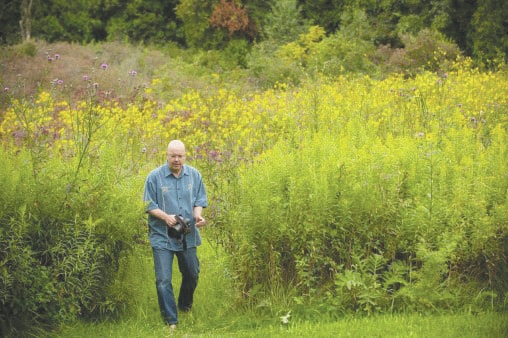For Greene County News
FAIRBORN – The weathered, white-brick house slouches at the edge of Cedar Bog, a 450-acre wetland and nature preserve in west central Ohio. The air pulses with the chir of crickets. Butterflies float over patches of purple and yellow wildflowers. A fallen tree arrows out of a pond.
It’s a homecoming of sorts for Wright State University professor emeritus Ron Geibert, who lived in the 1860s-era house on the bog when he launched his Wright State career in 1980.
Today, the 63-year-old Geibert is an accomplished, portfolio-rich artist whose photographs can be found in New York City’s Museum of Modern Art, the Bibliothèque Nationale in Paris and the Smithsonian, Library of Congress and Corcoran Gallery in Washington, D.C., and elsewhere.
A pioneer of color photography, he currently is in the acquisition process of adding his photographs to art museums in Tokyo, San Francisco, San Diego and other suitors looking to fill historic and aesthetic holes in their collections.
“To get added again to significant collections 30-plus years after the photographs were made early in my career is amazing,” Geibert said. “It’s kind of like being in the Hall of Fame because it’s a legitimate, valid, Better-Homes-and-Gardens seal of approval. You’re somebody.”
Geibert was born in Jamestown, North Dakota, but grew up in Nebraska. His father was a Lutheran minister, who died at the age of 48, and his mother was a secretary at Creighton University in Omaha.
As a boy, Geibert liked to launch model rockets and aspired to be an aerospace engineer. But he soured on aerospace as a career while at Creighton and — because he liked to draw rockets as a child — began taking art classes.
One day while in the campus library, he discovered a book on the works of Edward Weston, an acclaimed 20th century photographer who made black-and-white photos of the people and places of the American West and was famous for his photographs of trees and rocks in California. Geibert instantly realized that photographing Nebraska landscapes — but in color — was his calling.
“This book changed my life,” he recalled. “That’s when I became an artist with an 8X10 view camera. I bought a four-wheel-drive vehicle and built a platform on top so I could stand elevated above the flat terrain.”
After graduating from Creighton and teaching middle-school art, Geibert went to graduate school at the University of Nebraska-Lincoln, where he introduced color photography into the fine arts program.
Geibert would go on to photograph rodeos and fairs around Nebraska, producing beautiful, color-rich shots of people, animals and prize-winning produce, including a vibrant photograph of canned jars of pickles and pears draped with contest ribbons.
“It tells the experience of going to a Nebraska fair in as clean, pristine, balanced, pure way that I can imagine,” he said. “It doesn’t have an agenda. It’s not commercial looking.”
Now a practitioner of street photography, Geibert says, “I needed action. I related more to a dance choreographer. How am I going to put several different puzzles together into one puzzle … and find the moment where there is clarity and balance and beauty and mystery?”
Geibert’s photography in Nebraska got Wright State interested in him. In the spring of 1980, the university offered him a temporary quarter teaching position as a visiting artist. He rented a room at the house on Cedar Bog during the quarter and returned to Nebraska when the appointment ended. Then, to his delight, he was hired by Wright State the following year to permanently teach photography.
The occupants of the house — naturalist Terry Jaworski, the bog’s site manager, and his wife, Carol, an art history major at Wright State who extended the rental invitation to Geibert — were committed and passionate about the bog, a beautiful contemplative space that is home to white cedar, orchids, birch, spotted turtles and tortoise-shell butterflies. The couple’s passion for the bog deepened Geibert’s own passion for photography.
“It made me realize there are other people like me who are so passionate about something,” he said. “It validated that kind of approach — a constant focus.”
Now an Ohioan, Geibert traveled southwest Ohio from 1981 to 1984, capturing the activities and events and, in particular, the movement and human element of youth sporting competitions. One poignant image shows an injured football player reclining on a sideline bench, propping up his bandaged foot.
At the end of his first decade at Wright State, Geibert participated in Wright State international exchange programs, making photographs in Japan and Germany.
Then, in the two decades that followed, his interest and pioneering research in a new field — multimedia — transformed his teaching and curatorial activities into CD-ROM publications of photography exhibitions and his creative work into sculptural electronic kiosks dealing with Orwellian “Big Brother” issues.
Geibert, who now lives in Beavercreek, retired in 2008 at age 56 after more than 27 years with the university. He says Wright State supported him in exploring new things, even if they were a little outside of his range.
“They were just an invaluable family of resources, encouragement and friends and colleagues,” he said.







